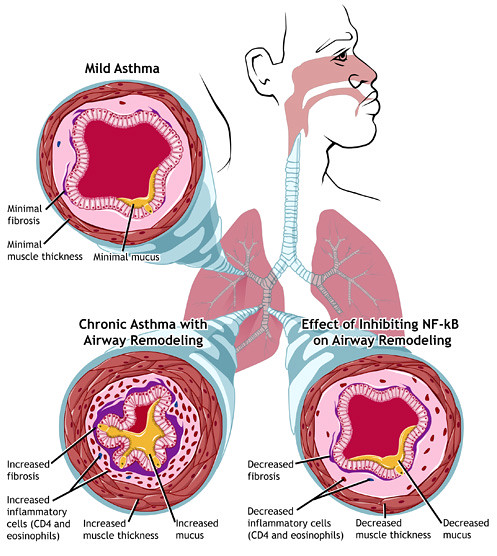Difference Between Extrinsic Asthma and Intrinsic Asthma
What is Extrinsic Asthma and Intrinsic Asthma?
Asthma is a chronic (long-term) lung condition in which the airways (breathing tubes) become inflamed, irritated and narrowed. This results in coughing, shortness of breath, chest tightness, and wheezing. Allergic asthma and non-allergic asthma are subtypes of asthma.
Both extrinsic asthma and intrinsic asthma are 2 subtypes of asthma. These are also termed as allergic asthma and nonallergic asthma.
Both subtypes of asthma show similar symptoms. Because of this, their treatment measures are also similar. However, the major difference between the two is their causes and the triggers. The prevention strategies also differ.
Both types of asthma involve the production of antibody called immunoglobin E (IgE) locally at the air tubes in response to the relevant triggers.

Extrinsic Asthma
Extrinsic or allergic asthma happens when the immune system overreacts to a harmless substance, such as plant pollens or house dust. The body releases an antibody termed as IgE – immunoglobin E. The release of this antibody results in swelling (inflammation) and asthma symptoms.

Intrinsic Asthma
Intrinsic asthma or non -allergic asthma occurs when something other than allergens triggers an immune system response. It is hard to identify the potential trigger that results in intrinsic asthma in most of the cases.
Difference between Extrinsic Asthma and Intrinsic Asthma
Definition
Extrinsic asthma
Extrinsic asthma (allergic asthma) is the asthma caused by a chronic allergic reaction. If your asthma is allergic or extrinsic, you will have increased levels of Immunoglobulin E (IgE) present in the blood test.
Intrinsic asthma
In Intrinsic asthma (non-allergic asthma), IgE is only locally involved and this asthma is triggered by several non-allergic factors like cold weather, dry weather, stress and anxiety, viruses or infections, smoke and more.
Prevalence
Extrinsic asthma
This type of asthma is very common. Sixty percent people with asthmatic symptoms suffer from allergic asthma or extrinsic asthma as per the Asthma and Allergy Foundation of America.
Intrinsic asthma
It is less common in comparison to allergic or extrinsic asthma. Only ten percent to thirty percent of people suffering from asthma develop intrinsic or non-allergic asthma as per The Journal of Allergy and Clinical Immunology.
It develops more often in women in comparison to males and typically occurs later in life than allergic asthma extrinsic asthma.
Common triggers
Extrinsic asthma
Common triggers for extrinsic asthma include:
- Dust mites
- House dust
- Pet dander
- Horse hair
- Feathers
- Plant Pollen
- Mold
- fungal spores
- Cockroaches
- Furniture stuffing
- Rodents
- Foods like fish (shellfish), berries, tomatoes, cow’s milk, cereals, eggs and chocolate
- Drugs like sulfites, Penicillin, and aspirin
Intrinsic asthma
Common triggers for intrinsic asthma include;
- Stress
- Anxiety
- Cold air
- Upper respiratory viruses (respiratory infections like the common cold)
- Cigarette smoke
- Environmental and air pollution
- Changes in weather
- Dry air
- Wood or fireplace smoke
Diagnosis
Extrinsic asthma
- lung X-ray and blood work in addition to a thorough physical examination
- Spirometry
- Peak flow, or lung function tests
- All of the above-mentioned tests as well as a skin prick test, to find out what the body perceives as an allergen.
Intrinsic asthma
- lung X-ray and blood work in addition to a thorough physical examination
- Spirometry
- Peak flow, or lung function tests
- After that, your physician may perform an analysis on what factor(s) result in your non-allergic or intrinsic asthma.
How is each asthma treated?
Extrinsic asthma
Extrinsic (allergic) asthma treatment involves a tandem treatment approach
It involves treatment of asthma along with the allergies. Extrinsic asthma treatment will involve medications from the doctor meant to address the problem of irritation and reduce the swelling or inflammation. Allergy treatment along with asthma treatment will depend on the allergen causing the symptoms and the severity of the symptoms.
Diet and lifestyle changes are recommended, in addition to traditional allergy medicine.
Intrinsic asthma
After your physician identifies the causes and reasons that are responsible for your non-allergic or intrinsic asthma, he will recommend certain treatment and precaution measures to address the specific triggers. These measures include lifestyle changes, changes in diet, nutrition and the environment. The doctor may also prescribe certain drugs and medications, like steroids and antibiotics, that will address the inflammation and infection caused by certain triggers.
If your non- allergic or intrinsic asthma is triggered by tension or anxiety, psychological counselling may also be recommended for treating your non-allergic asthma.
Prevention strategies (reducing triggers)
The following preventive strategies help people with extrinsic asthma:
- Use of vacuum cleaner to minimize dust
- Fixing pipes that are leaking for prevention of mold build-up
- Doors and windows should be shut properly to avoid the pollen
- Pets should be kept out of the bedrooms and living rooms.
Intrinsic asthma
People with intrinsic asthma should avoid dry, humid and cold weather.
Summary
The points of difference between Extrinsic asthma and Intrinsic asthma have been summarized as below:
Extrinsic Asthma Vs. Intrinsic Asthma

- Difference Between Global Warming and Greenhouse Effect - May 18, 2024
- Difference Between Vaccination and Immunization - March 3, 2024
- Difference Between Selective Mutism and Autism - February 25, 2024
Search DifferenceBetween.net :
Leave a Response
References :
[0]Image credit: https://live.staticflickr.com/4011/5081431722_12ebc9227b_z.jpg
[1]Image credit: https://commons.wikimedia.org/wiki/File:An_Asthma_patient_taking_medication_using_an_inhaler.png
[2]Corrigan, C. (2004). Mechanisms of intrinsic asthma. Current opinion in allergy and clinical immunology, 4(1), 53-56.
[3]Mathur, S. K., & Viswanathan, R. K. (2014). Relevance of allergy in adult asthma. Current allergy and asthma reports, 14(5), 437.
[4]Mays, E. E. (1976). Intrinsic asthma in adults: association with gastroesophageal reflux. Jama, 236(23), 2626-2628.
[5]Ulrik, C. S., Backer, V., Dirksen, A., Pedersen, M., & Koch, C. (1995). Extrinsic and intrinsic asthma from childhood to adult age: a 10-yr follow-up. Respiratory medicine, 89(8), 547-554.
